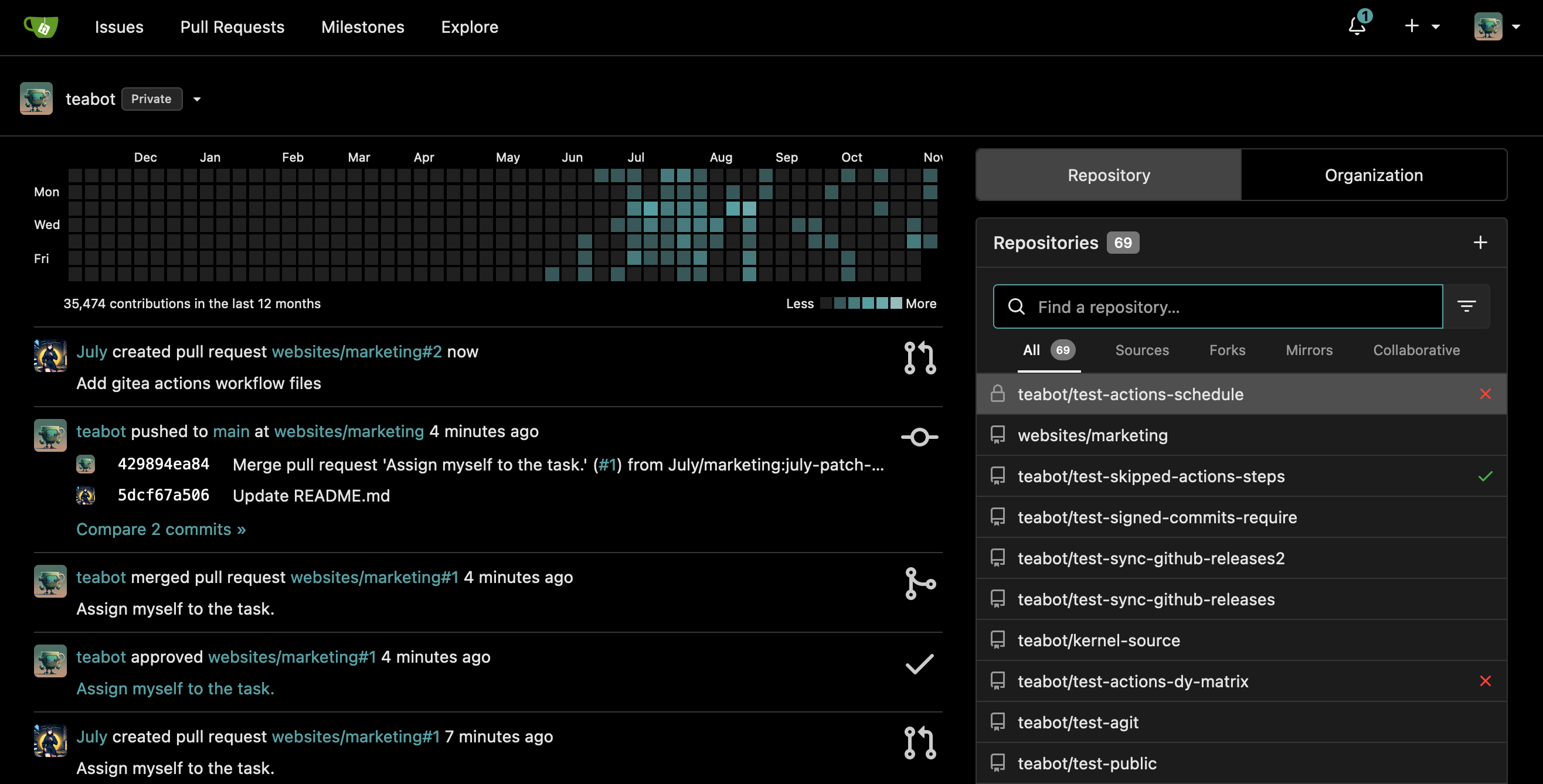Gitea
- Install Gitea
- Expose Gitea using Swag
Gitea is a self-hosted DevOps platform that allows you to manage repositories much like GitHub, but on your own infrastructure.

Installation
Folder structure
root
└── docker
└── gitea
└── data
Open Dockge, click on compose, name the stack gitea, and paste the following content:
---
networks:
gitea:
external: false
services:
server:
image: gitea/gitea:1.22.0
container_name: gitea
environment:
- USER_UID=${UID}
- USER_GID=${GID}
- TZ=Europe/Paris
restart: unless-stopped
networks:
- gitea
volumes:
- ./data:/data
ports:
- 3333:3000
- 222:22
Fill out the .env file with the required information, for example:
UID=1000
GID=1000
Deploy the container and go to http://yourserverip:3333. Your Gitea instance is now up and running!
- If it fails: check your firewall rules.
Exposing Gitea with Swag
The benefit of this setup is being able to access it remotely from any of your devices. To do so, we’ll expose Gitea through Swag.
- Prerequisite: We assume you have created a subdomain such as
gitea.yourdomain.comin your DNS zone withCNAMEpointing toyourdomain.com, and unless you're using Cloudflare Zero Trust, you have already forwarded port443from your router to your server’s port443in the NAT rules.
In Dockge, go to the SWAG stack and edit the compose file by adding Gitea's network:
services:
swag:
container_name: # ...
# ...
networks: # Connect the container to the custom network
# ...
- gitea # Name of the declared network
networks: # Define the custom network
# ...
gitea: # Name of the declared network
name: gitea_default # Actual external network name
external: true # Indicates it's an external network
- We assume the Gitea network name is
gitea_default. You can verify connectivity by visiting the SWAG dashboard at http://yourserverip:81.
Redeploy the stack by clicking "Deploy" and wait until SWAG is fully operational.
Inside the Swag folders, create the file gitea.subdomain.conf.
sudo vi /docker/swag/config/nginx/proxy-confs/gitea.subdomain.conf
Press i to enter edit mode and paste the configuration below:
## Version 2023/12/19
server {
listen 443 ssl;
listen [::]:443 ssl;
server_name gitea.*;
include /config/nginx/ssl.conf;
client_max_body_size 0;
# enable for ldap auth (requires ldap-location.conf in the location block)
#include /config/nginx/ldap-server.conf;
# enable for Authelia (requires authelia-location.conf in the location block)
#include /config/nginx/authelia-server.conf;
# enable for Authentik (requires authentik-location.conf in the location block)
#include /config/nginx/authentik-server.conf;
location / {
# enable the next two lines for http auth
#auth_basic "Restricted";
#auth_basic_user_file /config/nginx/.htpasswd;
# enable for ldap auth (requires ldap-server.conf in the server block)
#include /config/nginx/ldap-location.conf;
# enable for Authelia (requires authelia-server.conf in the server block)
#include /config/nginx/authelia-location.conf;
# enable for Authentik (requires authentik-server.conf in the server block)
#include /config/nginx/authentik-location.conf;
include /config/nginx/proxy.conf;
include /config/nginx/resolver.conf;
set $upstream_app gitea;
set $upstream_port 3000;
set $upstream_proto http;
proxy_pass $upstream_proto://$upstream_app:$upstream_port;
}
location ~ (/gitea)?/info/lfs {
include /config/nginx/proxy.conf;
include /config/nginx/resolver.conf;
set $upstream_app gitea;
set $upstream_port 3000;
set $upstream_proto http;
proxy_pass $upstream_proto://$upstream_app:$upstream_port;
}
}
Press Esc, then save and exit by typing :x and hitting Enter.
Now open the app.ini file from the container's file system:
sudo vi /docker/gitea/data/gitea/conf/app.ini
Press i to edit, then modify the server section with your domain information:
[server]
DOMAIN = gitea.yourdomain.com
SSH_DOMAIN = gitea.yourdomain.com
ROOT_URL = https://gitea.yourdomain.com/
Press Esc, save and exit with :x, then restart the container.
And that’s it! Gitea is now exposed to the web.
